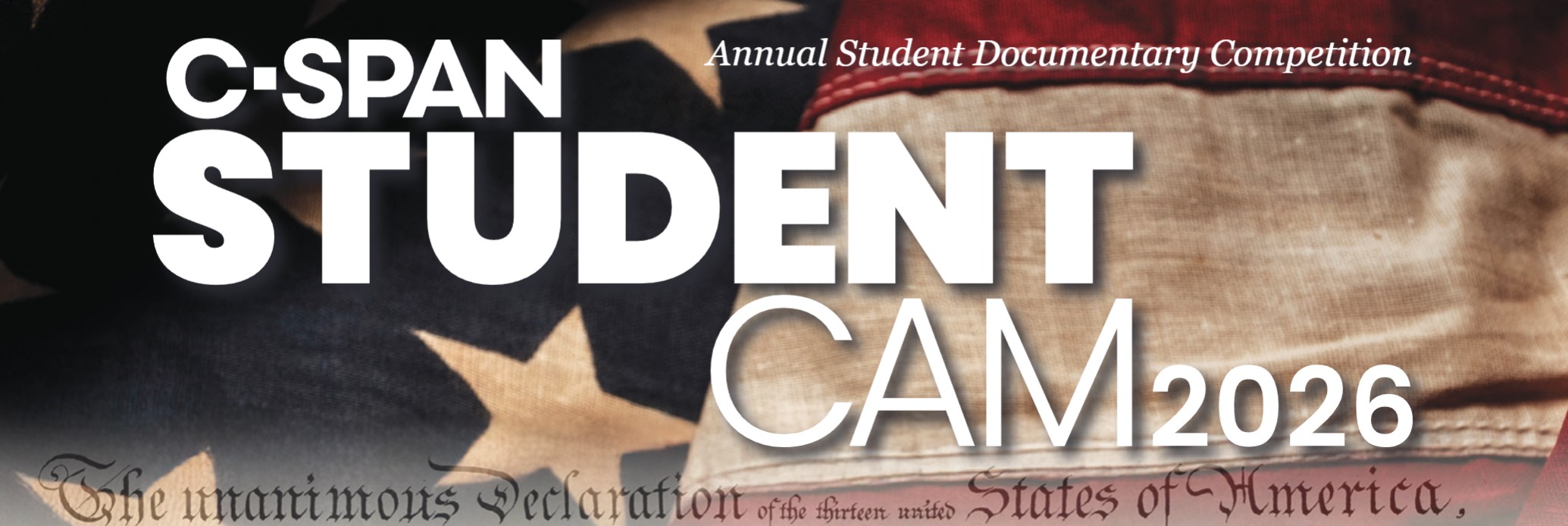
StudentCam Competition Rules
Click here for a printable Student Checklist. (Google Doc)
1. The entry should reflect this year’s theme:
“America’s 250th Anniversary”
Exploring the American Story through the Declaration of Independence
Students are asked to create a 5- to 6-minute documentary that explores the enduring impact
of the Declaration of Independence by examining:
(1) its influence on a key moment from America’s 250-year history
– or –
(2) how the values stated in the foundational document touch on a contemporary issue impacting you or your community.
The entry must be the original work of the student(s), hereafter referred to as “entrant(s).”
2. This competition is open to entrants currently enrolled in middle or high school in any state in the United States, the District of Columbia, and U.S. territories. International students in the equivalent of U.S. grades 6-12 and aged 18 years or younger may also participate. Students may be enrolled in public or private schools, or be home-schooled.
Students in grades 6-8 will be considered “middle school” entrants; grades 9-12 will be considered “high school” entrants.
3. The employees and officers of the National Cable Satellite Corporation and their immediate family members, and the Trustees of the C-SPAN Education Foundation and their immediate family members are not eligible to participate in the contest.
4. The documentary (minus end credits) must be between 5:00 and 6:00 minutes in length. Documentaries that are shorter than 5:00 or longer than 6:00 will be disqualified in the first round of judging. End credits, if applicable, must begin after the 5:00 minute mark, but are permitted to run longer than the maximum allotted 6:00 minute documentary time frame.
5. Video clips of topically-related C-SPAN programming must be included in the video documentary. We suggest students use multiple C-SPAN clips throughout, including b-roll, contextual background information, and supporting or opposing viewpoints related to the documentary topic, but the use of C-SPAN video need not be excessive to the point that it detracts from your original production.
Winning StudentCam documentaries will also thoroughly explore a variety of viewpoints related to chosen documentary topic, including those that may oppose the filmmakers’ own points of view. Students may share their own personal viewpoints but since C-SPAN is a non-partisan television network, we highly recommend that students strive to demonstrate a balanced presentation of differing viewpoints, including those that may differ from their own.
6. Limited use of copyrighted material will be permitted in the entry so long as it is a lawful or “fair” use, and so long as such use does not overwhelm the original contribution of the student(s). Click here for an explanation from American University’s Center for Media and Social Impact, describing “Documentary Filmmakers’ Best Practices in Fair Use.”
7. Entrants must credit all non-C-SPAN video sources that are used to create the video documentary. Students should also cite any images or graphics that are not their own, as well as any information that informs their narration. These citations can be listed either in the end credits of the documentary, or in a separately submitted works-cited list. Your works cited list may be in the format of your choice and uploaded along with your Entry Form, or submitted via email to educate@c-span.org.
8. Individuals or a team of up to 3 students may create and submit an entry. C-SPAN will recognize a maximum of 3 students per entry. A single entry that is created by more than 3 students will be disqualified from prize contention.
A student may submit only one entry per year that they are eligible to participate, whether they are participating as an individual or in a group.
9. As a competition for middle and high school students, we expect entries to be free of profanity, gratuitous violence, gore and derogatory content. A good way to gauge what is acceptable would be to think of whether the completed documentary is something that teachers and your school administration would be comfortable showing your video in a school setting with invited parents and guests.
10. School staff and faculty may provide guidance and critiques but may not participate in conceiving and producing the video. Students are not required to have a teacher adviser in order to participate. If a teacher acts as an adviser, his or her name must be listed on the student’s Entry Form in order for them to be eligible for the StudentCam adviser cash prize.
11. Entries must be uploaded and submitted online. After uploading to your choice of video host such as Google Drive, YouTube, Dropbox or WeVideo, students must submit the link to their video via their completed online Entry Form, anytime through the end of the day on January 20, 2026.
12. All eligible entries must be successfully uploaded by 11:59pm Pacific Standard Time at the end of the day on January 20, 2026.
13. Middle School entries will be judged nationally against all of their peers from across the country. High School entries will be judged regionally against their peers in one of 3 Regions (West/Central/East), based on the state of the school that the student(s) attend. A map of the 3 High School regions can be found on our Prizes page.
14. Winning entries will become the shared property of National Cable Satellite Corporation, d/b/a C-SPAN.
Prize-winning entrants grant permission to C-SPAN to use their names, likenesses and videos for purposes expressly related to the StudentCam competition and events such as school award ceremonies following the announcement of the winning entries.
By submitting an entry, entrants (i) represent that their entries constitute original works of creativity that do not violate the property rights of any other person, and (ii) grant C-SPAN the right to televise, link to their video on studentcam.org, and publish it on our social media platforms if their video is selected as one of the 150 prize winners.
Students retain all other rights and are free to independently publish their video elsewhere online and on social media, and enter their work in other video competitions and/or film festivals.
15. Prize recipients will be determined by judges selected by C-SPAN and the judges’ decisions will be final.
If a team’s entry wins, C-SPAN will divide the prize money equally among the team members.
Per IRS rules on reporting income, prize recipients who win cash prizes of a higher value than $600 will be asked to complete and return IRS From W-9, provide a social security number and will be responsible for any taxes associated with their prize. If a student who wins a cash prize higher than $600 does not provide their social security number, they will still be recognized as a winner but will not receive the prize money.
C-SPAN reserves the right not to award all prizes in all categories; and C-SPAN reserves the right to not televise a winning video.
16. C-SPAN reserves the right to award a secondary prize of “Fan Favorite” to one of the top prize-winning entries that is based on the results of a period of online public voting prior to the March announcement of winning entries.
17. Prize recipients will be announced on C-SPAN and on StudentCam.org in March, 2026.



